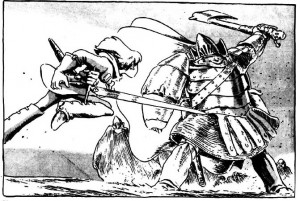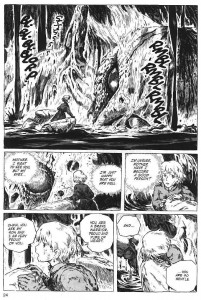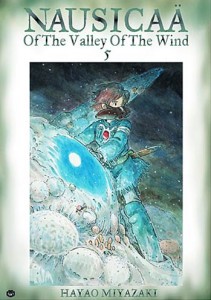SF Manga 101: Nausicaä of the Valley of the Wind
Glenn Hough (gallyangel) is a nonpracticing futurist, an anime and manga otaku, and is almost obsessive about finishing several of the lists tracked on WWEnd. In this series on SF Manga Glenn will provide an overview of the medium and the place of science fiction within it.
To a certain section of the population the name Hayao Miyazaki should be familiar. If you’ve ever paid any attention to the Oscars, especially in the animated feature category, the 2002 win by Spirited Away should leap to mind. Miyazaki was the director.
It is not a overstatement to say that Hayao Miyazaki is one of the gods of animation in Japan. He should be mentioned in the same sentence with early Disney and Chuck Jones. His movie My Neighbor Totoro has been compared to a perfect summers day; were both the movie and the day are equally, delightfully, plotless. It’s said of Spirited Away that it’s a reflection of the Japanese soul, which includes bathhouses, spirits, and the ever recurrent need of youth to find and embrace their courage in the world.
What does this have to do with SF Manga? It’s simple. In Miyazaki’s early days, he was the mangaka who slowly wrote and drew, taking 12! years, the manga that’s in second place on my list: Nausicaä of the Valley of the Wind.
Yes, the name of the title character comes directly from Homer’s Odyssey. Homer’s Nausicaä is a young princess. Miyazaki’s Nausicaä is a young princess. And that is where their similarities end.
 Miyazaki’s prologue to Nausicaä:
Miyazaki’s prologue to Nausicaä:
In a few short centuries, industrial civilization had spread from the western fringes of Eurasia to sprawl across the face of the planet. Plundering the soil of it’s riches, fouling the air, and remolding life forms at will, this gargantuan industrial society had already peaked a thousand years after it’s foundation: ahead lay abrupt and violent decline. The cities burned, welling up as clouds of poison in the war remembered as the seven days of fire. The complex and sophisticated technological superstructure was lost; almost all of the surface of the Earth was transformed into a sterile wasteland. Industrial civilization was never rebuilt as mankind lived on through the long twilight years…
Even after all this time, that prologue gives me chills. This manga first began serialization in February of 1982. I hear reflections of the M.A.D. (Mutually Assured Destruction) policy. I hear the echoes of the Club of Rome and their overshoot and collapse models. There is Rachel Carson’s Silent Spring lurking like a wicked stepmother. The one thing which seems to be missing from this mix of background elements is nuclear winter. But this is understandable since the first computational modeling on nuclear winter was not done until the 1982-1983 years, with publication of data in December of ’83. The term “nuclear winter” was coined just prior to publication. Since Miyazaki had already set Nausicaä is motion, this piece of science could probably not be incorporated, even if he knew about it.
Nausicaä, as central character, is a busy young woman. She’s princess Nausicaä, daughter of the ruling chief in The Valley of the Wind, and heir apparent. She’s a warrior princess. She flies the Valley’s one working fighter, and can fight on the ground with the enragement of a rampant Ohmu. Nausicaä has empathic and telepathic receptivity, so she can know the intentions of everything, from the growing trees and creatures of the Sea of Corruption, to the scattered tribes and empires of humanity with all their various tongues. Nausicaä even does some scientific work, in trying to understand why the Sea of Corruption is so poisonous. Nausicaä then gains religious status, messiah status, and a following as she travels since she fits ancient prophecy, which now seems to be coming true. All of that and Nausicaä must face a even tougher challenge, mother a god-warrior of the ancient past.
 Readers should quickly see how the environment shapes the cultures Miyazaki is working with. Everything revolves around the poisonous Sea of Corruption, which is populated by flora, fauna, and creatures which even surpass the levels of creativity that we see in Frank Herbert’s Dune.
Readers should quickly see how the environment shapes the cultures Miyazaki is working with. Everything revolves around the poisonous Sea of Corruption, which is populated by flora, fauna, and creatures which even surpass the levels of creativity that we see in Frank Herbert’s Dune.
The plot then is driven by the slowly/rapidly expanding Sea of Corruption which devours habitable land. The competition/war for land is then complicated by reviving ancient technology from the lost civilizations of the past. It’s like a cold war which is going along at the skirmish stage and then suddenly and drastically gets very hot. Does that sound like an early ’80’s concern? It does. Reagan was in office here and Andropov was in office in the USSR. For two decades people had been convinced that any day the bombs would fall; that we could go from cold to hot in an instant; that a technological edge would change the balance of power. Which is exactly what happens in Nausicaä’s world. I think it’s obvious that a lot of what was going on in the world as Miyazaki wrote/drew Nausicaä plays itself out in the manga. Nausicaä’s ability as a pilot, flight itself, is a theme Miyazaki returns to often in his works. He also returns to environmental issues in later works. Those are both strong threads running throughout his body of work.
 And yet this isn’t a manga about the 80’s. All the clichés are true. It’s epic; it’s mythic; it’s timeless; it’s relevant, outstandingly relevant as we face climate change, which was only on the minds of futurists when this was written. Even the bits about the long buried secret technology seem very relevant, even prophetic, if we factor in what some people say about what goes on in our black world of black ops, black programs, S.A.P.s (Special Access Programs) or the secret space programs.
And yet this isn’t a manga about the 80’s. All the clichés are true. It’s epic; it’s mythic; it’s timeless; it’s relevant, outstandingly relevant as we face climate change, which was only on the minds of futurists when this was written. Even the bits about the long buried secret technology seem very relevant, even prophetic, if we factor in what some people say about what goes on in our black world of black ops, black programs, S.A.P.s (Special Access Programs) or the secret space programs.
Now, as I reread Nausicaä, I’m thinking I should change my vote. Ghost in the Shell could easily be number 2…
Nausicaä of the Valley of the Wind can be found from the publisher Viz, or from your favorite online or brick and mortar retailer. There are multiple editions, including a brand new hardcover collection.



















 Full Details
Full Details




No comments yet.
Sorry, the comment form is closed at this time.